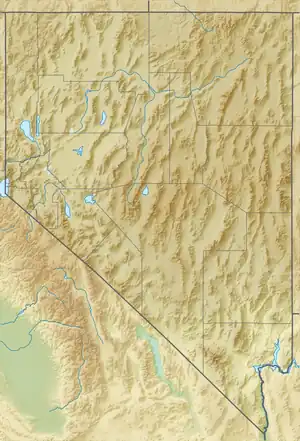| Mt. Grant | |
|---|---|
| Kurangwa (Northern Paiute) | |
 Mount Grant, with Walker Lake in the foreground | |
| Highest point | |
| Elevation | 11,285 ft (3,440 m) NAVD 88[1] |
| Prominence | 3,920 ft (1,195 m)[1] |
| Listing | Nevada County High Points 7th[2] |
| Coordinates | 38°34′06″N 118°47′28″W / 38.568409°N 118.791119°W[1] |
| Geography | |
 Mt. Grant | |
| Location | Mineral County, Nevada, U.S. |
| Parent range | Wassuk Range |
| Topo map | USGS MOUNT GRANT |
Mount Grant is both the highest and most topographically prominent mountain in both the Wassuk Range and Mineral County in Nevada, United States. It ranks thirteenth among the most topographically prominent peaks in the state.[3] The peak is located within the Hawthorne Army Depot, resulting in very limited public access.[4]
Mount Grant was named after Ulysses S. Grant (1822–1885), general of the Union during the American Civil War and afterward 18th President of the United States.[5]
Mount Grant (Northern Paiute: Kurangwa), plays a major role in the creation story of the groups of Northern Paiute people whose ancestors periodically lived near the mountain during their seasonal migrations. Kurangwa is a sacred being to them and is responsible for the creation of the Walker Lake (Agai Pah).[6]
Climate
| Climate data for Mount Grant (NV) 38.5686 N, 118.7908 W, Elevation: 10,938 ft (3,334 m) (1991–2020 normals) | |||||||||||||
|---|---|---|---|---|---|---|---|---|---|---|---|---|---|
| Month | Jan | Feb | Mar | Apr | May | Jun | Jul | Aug | Sep | Oct | Nov | Dec | Year |
| Mean daily maximum °F (°C) | 31.1 (−0.5) |
29.3 (−1.5) |
32.1 (0.1) |
36.7 (2.6) |
45.3 (7.4) |
55.9 (13.3) |
64.9 (18.3) |
64.1 (17.8) |
57.6 (14.2) |
47.4 (8.6) |
36.9 (2.7) |
30.4 (−0.9) |
44.3 (6.8) |
| Daily mean °F (°C) | 22.3 (−5.4) |
20.3 (−6.5) |
22.7 (−5.2) |
26.2 (−3.2) |
33.4 (0.8) |
42.9 (6.1) |
51.0 (10.6) |
50.1 (10.1) |
44.8 (7.1) |
36.2 (2.3) |
28.0 (−2.2) |
22.2 (−5.4) |
33.3 (0.8) |
| Mean daily minimum °F (°C) | 13.5 (−10.3) |
11.4 (−11.4) |
13.2 (−10.4) |
15.7 (−9.1) |
21.5 (−5.8) |
29.9 (−1.2) |
37.0 (2.8) |
36.1 (2.3) |
31.9 (−0.1) |
25.0 (−3.9) |
19.2 (−7.1) |
14.0 (−10.0) |
22.4 (−5.4) |
| Average precipitation inches (mm) | 3.30 (84) |
2.96 (75) |
2.98 (76) |
1.92 (49) |
1.53 (39) |
0.82 (21) |
0.92 (23) |
0.71 (18) |
0.70 (18) |
1.35 (34) |
1.88 (48) |
2.97 (75) |
22.04 (560) |
| Source: PRISM Climate Group[7] | |||||||||||||
References
- 1 2 3 "Mount Grant". Peakbagger.com. Retrieved 2015-01-22.
- ↑ "Nevada County High Points". Peakbagger.com. Retrieved 2015-01-22.
- ↑ "Nevada Peaks with 2000 feet of Prominence". Peakbagger.com. Retrieved 2015-01-22.
- ↑ "Mount Grant". SummitPost.org.
- ↑ Federal Writers' Project (1941). Origin of Place Names: Nevada (PDF). W.P.A. p. 52.
- ↑ Ginny Bengston (2002). "Northern Paiute and Western Shoshone Land Use in Northern Nevada: A Class I Ethnographic/Ethnohistoric Overview". SWCA Environmental Consultants. pp. 90-91. Retrieved 2022-12-31. https://www.blm.gov/sites/default/files/documents/files/Library_Nevada_CulturalResourceSeries12.pdf
- ↑ "PRISM Climate Group, Oregon State University". PRISM Climate Group, Oregon State University. Retrieved October 8, 2023.
To find the table data on the PRISM website, start by clicking Coordinates (under Location); copy Latitude and Longitude figures from top of table; click Zoom to location; click Precipitation, Minimum temp, Mean temp, Maximum temp; click 30-year normals, 1991-2020; click 800m; click Retrieve Time Series button.